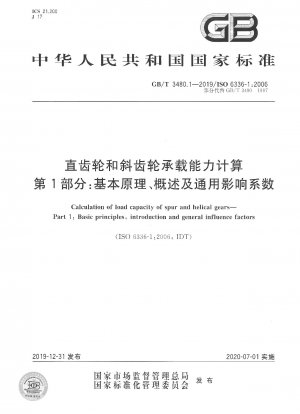GB/T 3480.1-2019
Calculation of load capacity of spur and helical gears—Part 1: Basic principles, introduction and general influence factors (English Version)
- Standard No.
- GB/T 3480.1-2019
- Language
- Chinese, Available in English version
- Release Date
- 2019
- Published By
- 国家市场监督管理总局、中国国家标准化管理委员会
- Latest
- GB/T 3480.1-2019
- Replace
- GB/T 3480-1997
- Scope
- This part of GB/T3480 introduces the basic principles, overview and general influence coefficients of the calculation of the load carrying capacity of spur gears and helical gears. Together with ISO6336-2 ISO6336-3 ISO6336-5 and ISO6336-6, it provides a way to compare different gear designs. It is neither used to guarantee the performance of the assembled craftsman's wheel device, nor is it used by general engineers, but is used by experienced gear designers who can reasonably value the coefficients in the formula based on knowledge of similar designs, and clearly understand What impact does each value have on the calculation results? The formulas in GB/T3480 are proposed to provide a widely accepted method for calculating the tooth surface contact strength and root bending strength of involute cylindrical spur gears or helical gears. GB/T3480 includes the results based on experimental and theoretical research by Hirtt, Strasser2] and Brossmann[3]. The results calculated using this method are quite consistent with the results of previously accepted calculation methods (for the case where the normal working pressure angle does not exceed 25" and the indexing circle helix angle does not exceed 25", see references [4-[8]) . For larger pressure angles and helix angles, the trends of the product of YrYsys and the products of ZaZ and Z8 are different from some previously applied methods. Users should note that when GB/T3480 is applied to this situation, its calculation results need to be confirmed based on experience. The formula in GB/T3480 does not apply to any of the following situations: ——The end surface coincidence degree of spur gear or helical gear pair is less than 1.0; ——The end surface coincidence degree of spur gear or helical gear pair is greater than 2.5; ——Tooth top and tooth Root interference, - lateral margin is 0. The formula in GB/T3480 does not apply to other forms of gear tooth damage, such as plastic yielding, surface crushing, gluing and wear, nor to unpredictable tooth profile damage that may be caused by vibration. The bending strength calculation formula is only applicable to the case of breakage at this root fillet, but does not apply to the breakage of gear teeth on the working surface, wheel rim failure, or wheel body failure caused by wheel spokes and wheel load. GB/T3480 is not suitable for wheels with forging or sintering as the final processing process, nor is it suitable for gear pairs with poor contact areas. 03480 people developed the calculation method for the load-bearing capacity of pitting corrosion and tooth root fracture on this surface. When the pitch circle speed is less than 1my/s, the load-bearing capacity of this wheel is usually limited by abrasive wear (please refer to other literature for calculations in this regard).
GB/T 3480.1-2019 history
- 2021 GB/T 3480.3-2021 Calculation of load capacity of spur and helical gears—Part 3: Calculation of tooth bending strength
- 1997 GB/T 3480-1997 Calculation methods of load capacity for involute cylindrical gears
- 0000 GB 3480-1983

GB/T 3480.1-2019 -All Parts
GB/T 3480.1-2019 Calculation of load capacity of spur and helical gears—Part 1: Basic principles, introduction and general influence factors
GB/T 3480.2-2021 Calculation of load capacity of spur and helical gears—Part 2: Calculation of surface durability (pitting)
GB/T 3480.3-2021 Calculation of load capacity of spur and helical gears—Part 3: Calculation of tooth bending strength
GB/T 3480.5-2021 Calculation of load capacity of spur and helical gears—Part 5:Strength and quality of materials
GB/T 3480.6-2018 Calculation of load capacity of spur and helical gears—Part 6:Calculation of service life under variable load